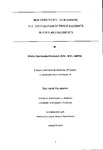NEW STRATEGIES TO DETERMINE THE DISTRIBUTION OF TRACE ELEMENTS IN SOILS AND SEDIMENTS
| dc.contributor.author | SANTAMARIA-FERNANDEZ, REBECA | |
| dc.contributor.other | Faculty of Science and Engineering | en_US |
| dc.date.accessioned | 2013-10-08T09:56:31Z | |
| dc.date.available | 2013-10-08T09:56:31Z | |
| dc.date.issued | 2004 | |
| dc.identifier | NOT AVAILABLE | en_US |
| dc.identifier.uri | http://hdl.handle.net/10026.1/2084 | |
| dc.description.abstract |
Sequential chemical extraction to fractionate metals in soils and sediments into different groups reflecting their "leachability" has been widely employed to determine distribution of metals in different physico-chemical phases. A large number of sequential extraction schemes have been reported, most of them modifications of Tessier's extraction protocol. Although this method has been widely accepted, it is important to highlight that sequential extraction procedures are often tedious and time consuming and that they also suffer from a number of limitations, such as the problem of achieving selective dissolution and the re-adsorption of trace metals during extraction. The objective of this study was to develop, optimise, characterise and apply a novel sequential extraction procedure for the evaluation of trace metal distribution in soils and sediments in order to speed up the process, but more importantly to provide robust data for further aid the chemical characterisation of such samples. The method developed used centrifugation to pass the extractant solution (HNO3) at increasing concentrations, through the soil/sediment sample. The sequential leachates were collected and analysed by ICP-AES for a suite of 18 analytes. The method then utilised chemometrics in order to facilitate processing of the data. Optimisation of the new extraction protocol was performed using an experimental design approach. This was important since the method employed multi-elemental analysis to predict the composition of the physico-chemical phases in a range of soils and sediments. The approach used for data processing was again novel and was based on a simple product of matrices. However many statistical and chemometric approaches are used throughout this thesis to aid both the design of the method and the interpretation of the data obtained. Once optimised, the methodology was evaluated using a range of reference materials and tentative assignments were made in order to characterise the different physico-chemical phases in the soils by comparison with previously obtained data following Tessier's protocol. Significant correlation was obtained for the exchangeable fraction, the fraction associated with carbonates and the iron and manganese oxides fraction. Hence the method proved to be effective in providing Important information in terms of metal distribution in agreement with established procedures. The method was then applied to the study of the effect of humic acids (HA) on trace metal distribution in two different samples. Both samples were spiked with increasing amounts of humic acids and the sequential extraction procedure was used to monitor the changes in metal distribution. Differences when HA were added were found for most of the physico-chemical components in both samples. This provided practical data to support the theoretical assumption that HA interact with the metals present in the soil samples changing their distribution. Using the new method, an evaluation of the trace metal distribution within the Arosa estuary (N.W. Spain) with respect to trace metal contamination was performed. Finally, an on-line automated multisequential extraction system was built "in-house", and coupled with the ICP-AES instrument to allow the fast characterisation of soils and sediment samples. The new system proved to be faster than the batch method and minimised the chance of sample mislabelling, sample contamination etc. Good agreement between results obtained from the on-line method, the batch method, and results using the Tessier scheme was obtained. The automated method clearly offers great potential for a range of environmental pollution studies aiding the quick identication of the physico-chemical components in geochemical samples. | en_US |
| dc.description.sponsorship | BRITISH GEOLOGICAL SURVEY, NOTTINGHAM | en_US |
| dc.language.iso | en | en_US |
| dc.publisher | University of Plymouth | en_US |
| dc.title | NEW STRATEGIES TO DETERMINE THE DISTRIBUTION OF TRACE ELEMENTS IN SOILS AND SEDIMENTS | en_US |
| dc.type | Thesis | en_US |
| plymouth.version | Full version | en_US |
| dc.identifier.doi | http://dx.doi.org/10.24382/1346 |
Files in this item
This item appears in the following Collection(s)
-
01 Research Theses Main Collection
Research Theses Main


